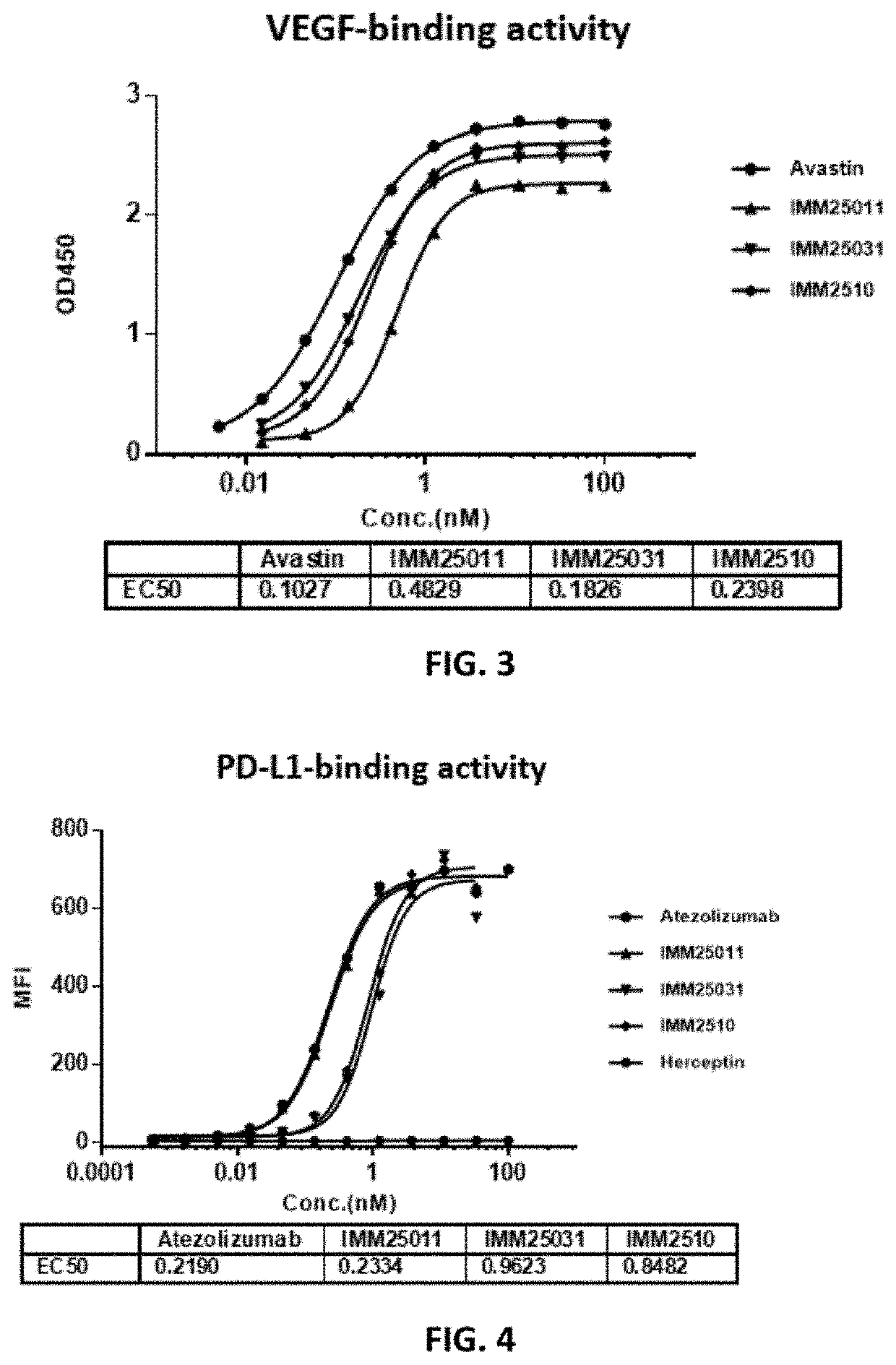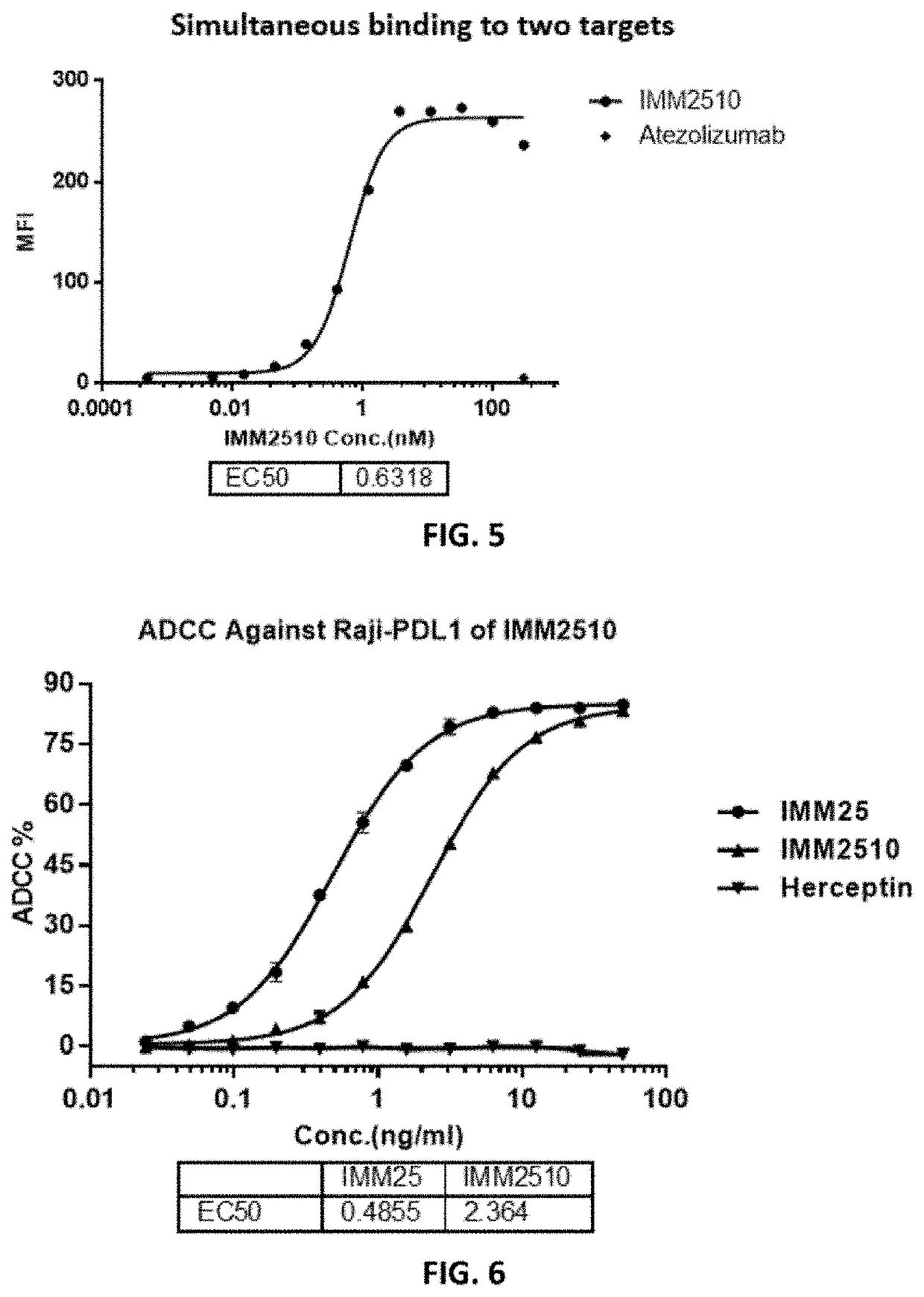Recombinant protein targeting PD-L1 and VEGF
a recombinant protein and anti-tumor technology, applied in the field of tumor therapies, can solve the problems of significant design challenges, inability to eliminate cancer cells, and insufficient response of patients to monospecific therapy, and achieve the effect of better anti-tumor activity
- Summary
- Abstract
- Description
- Claims
- Application Information
AI Technical Summary
Benefits of technology
Problems solved by technology
Method used
Image
Examples
example 1
Construction of Vectors Expressing IMM25, IMM25011, IMM25031 and IMM2510
[0094]1.1 IMM25
[0095]Full-length coding sequence of IMM25 was designed artificially. Specifically, 57 nucleotides encoding the signal peptide of mouse IgG1 heavy chain (SEQ ID NO.: 19) were added to the 5′ end of the anti-PD-L1 heavy chain-coding sequence (SEQ ID NO.: 1), and a Kozak sequence (SEQ ID NO: 20) was added to the 5′ end of the signal peptide sequence. Lastly, HindIII and NheI restriction sites were added to the 5′ and 3′ ends of the resulting sequence, respectively. For the light chain, the same signal sequence as well as the Kozac sequence was used, but HindIII and the XbaI restriction sites were added to the resulting sequence, respectively. The two resulting sequences were synthesized by Genscript (#: C0015BJ110-1 (heavy chain); C0015BJ110-2 (light chain)) and subcloned, respectively, into the pMac-H and pMac-L vectors.
[0096]1.2 IMM2510
[0097]Full-length coding sequence of IMM2510 was designed arti...
example 2
Manufacture and Quality Analysis of Recombinant Fusion Antibodies
[0102]To manufacture the recombinant proteins, the expression vectors were transfected into Free Style™ CHO-S cells (Thermo Fisher Scientific, Cat #R80007) using Polyetherimide (PEI) (polysciences, Cat #24765-1) as the tranfectant. Cells were cultured for about 7-10 days before harvesting cell culture supernatant for protein purification by affinity chromatography. The purity of the recombinant proteins was analyzed by SEC-HPLC.
[0103]The SEC-HPLC diagram in FIG. 2 showed a big difference among the three recombinant antibodies of the present disclosure. IMM2510 had the highest purity (90.67%), followed by IMM25011 (85.58%) and IMM25031 (71.97%). IMM25011 had high percentage of aggregates (15.42%), while IMM25031 had more degradation (27.11%).
example 3
Recombinant Antibodies Bound to VEGF-165
[0104]For VEGF binding, recombinant human VEGF-165 (Cat #11066-HNAH, Sino Biologicals) was prepared in coating buffer (Product code: 1001329288 C3041-100CAP, Sigma-Aldrich Co.) and transferred to the ELISA plate (Cat #442404, Nunc™) at 50 ng / well, and the plate was placed in 4° C. refrigerator overnight. Then, the plate was washed for three times with PBS containing 0.05% of Tween-20 (PBS-T) before serially diluted recombinant antibodies and control antibody (Avastin) were added, and the plate was incubated at room temperature for 1 hour and then washed again for 5 times with PBS-T. HRP-Rabbit Anti-Human IgG Fc (Cat #:309-036-008, Jackson ImmunoResearch Lab) was added to the plate and the plate was incubated at room for one hour. After washing the plate for 5 times with PBS-T, substrate was added to the plate which was read in a plate reader after the color changing was stopped by 1N H2SO4.
[0105]As shown in FIG. 3, the three recombinant antibo...
PUM
| Property | Measurement | Unit |
|---|---|---|
| concentration | aaaaa | aaaaa |
| concentration | aaaaa | aaaaa |
| concentration | aaaaa | aaaaa |
Abstract
Description
Claims
Application Information
 Login to View More
Login to View More - R&D Engineer
- R&D Manager
- IP Professional
- Industry Leading Data Capabilities
- Powerful AI technology
- Patent DNA Extraction
Browse by: Latest US Patents, China's latest patents, Technical Efficacy Thesaurus, Application Domain, Technology Topic, Popular Technical Reports.
© 2024 PatSnap. All rights reserved.Legal|Privacy policy|Modern Slavery Act Transparency Statement|Sitemap|About US| Contact US: help@patsnap.com










